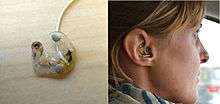Ear-EEG

Ear-EEG is a method for measuring dynamics of brain activity through the minute voltage changes observable on the skin, typically by placing electrodes on the scalp. In ear-EEG, the electrodes are exclusively placed in or around the outer ear, resulting in both a much greater invisibility and wearer mobility compared to full scalp EEG, but also significantly reduced signal amplitude, as well as reduction in the number of brain regions in which activity can be measured. It may broadly be partitioned into two groups: those using electrode positions exclusively within the concha and ear canal, and those also placing electrodes close to the ear, usually hidden behind the ear lobe. Generally speaking, the first type will be the most invisible, but also offer the most challenging (noisy) signal. Ear-EEG is a good candidate for inclusion in a hearable device, however, due to the high complexity of ear-EEG sensors, this has not yet been done.
History
Ear-EEG was first described in "A1 US patent US20070112277 A1",[1] though other noteworthy mentions are "B1 EP patent EP2448477 B1"[2] and "Auditory evoked responses from Ear-EEG recordings".[3] Since then, it has grown to be an endeavor spread across multiple research groups[4] and collaborations, as well as private companies [5] .[6] Notable incarnations of the technology are the cEEGrid [7][8] (see picture to the right) and the custom 3D-printed ear plugs from NeuroTechnology Lab (see picture above). Attempts at creating in-ear generic earpieces are also known to be under way.[9][10][11][12]

Uses in research
It is possible to think of multiple research areas in which an unobtrusive and invisible EEG system would be beneficial.[13] Good examples are in studies of group dynamics or didactics, in which cases it would be very valuable to be able to monitor the effect of various events on individuals, while still letting them experience said events unfettered. A promising use case is in long term sleep monitoring, where there is presently a need for a more user friendly (and cheaper) alternative to the gold standard polysomnography.[14]
In this context, it is very important to perform detailed comparisons between ear-EEG and regular scalp EEG, as results need to be comparable across platforms. This has been done in multiple papers.[7][15][16] In these it has been found that ear-EEG measurements are comparable to scalp EEG in the frequency domain, when comparing to electrodes in the temporal region, but that waveforms are generally different.
Possible commercial uses
Despite the lack of ear-EEG products on the market, several companies have revealed investments in ear-EEG technology. Foremost of these are the hearing aid producers Oticon [17] and Widex,[18] who are looking into hearing-aid applications, the feasibility of which there appears to be some support for,[19][20] and a hypoglycemia alarm. Smaller players, who never the less may be closer to bringing products to the market, are United Sciences [5] who recently had a highly successful Kickstarter campaign for their "Aware" hearable,[21] which will include EEG sensors, and Bragi, who have spoken of including EEG in a future version of their Dash hearable.[22]
Other potential use cases which are known to have been explored are driver drowsiness detection,[23] BCI[24] and biometric identification. [25]
References
- ↑ A1 US patent US20070112277 A1
- ↑ B1 EP patent EP2448477 B1
- ↑ Kidmose, Preben. Auditory evoked responses from Ear-EEG recordings. EMBC 2012. San Diego, Cal.
- ↑ Bleichner, Martin (6 April 2015). "Exploring miniaturized EEG electrodes for brain-computer interfaces. An EEG you do not see?". Physiol Rep. 3 (4doi=10.14814/phy2.12362). PMC 4425967
 .
. - 1 2 "The Aware". United Sciences. Retrieved 25 August 2016.
- ↑ Fiedler, Lorenz. Ear-EEG Allows Extraction of Neural Responses in Challenging Listening Scenarios – A Future Technology for Hearing Aids?. EMBC 2016. Orlando, Fl.
- 1 2 Debener, Stefan (17 November 2015). "Unobtrusive ambulatory EEG using a smartphone and flexible printed electrodes around the ear". Scientifif Reports. 5: 16743. doi:10.1038/srep16743. PMC 4648079
 .
. - ↑ "cEEGrid –". www.ceegrid.com. Retrieved 2016-11-14.
- ↑ Dong, Hao. A New Soft Material based In-The-Ear EEG Recording Technique. EMBC 2016. Orlando, Fl.
- ↑ Goverdovsky, Valentin. Generic Viscoelastic In-Ear EEG Monitor. EMBC 2016. Orlando, Fl.
- ↑ Goverdovsky, Valentin (1 January 2016). "In-Ear EEG From Viscoelastic Generic Earpieces: Robust and Unobtrusive 24/7 Monitoring". IEEE Sensors Journal. IEEE. 16 (1): 271–277. doi:10.1109/JSEN.2015.2471183.
- ↑ Norton, James (31 March 2015). "Soft, curved electrode systems capable of integration on the auricle as a persistent brain–computer interface". PNAS. 112 (13). doi:10.1073/pnas.1424875112. PMC 4386388
 .
. - ↑ Casson, Alexander (10 May 2010). "Wearable electroencephalography. What is it, why is it needed, and what does it entail?". IEEE Engineering in Medicine and Biology Magazine. 29 (3). doi:10.1109/MEMB.2010.936545.
- ↑ Stochholm, Andreas. Automatic Sleep Stage Classification using Ear-EEG. EMBC 2016. Orlando, Fl.
- ↑ Mikkelsen, Kaare (18 November 2015). "EEG Recorded from the Ear: Characterizing the Ear-EEG Method". Frontiers in Neuroscience. 9: 438. doi:10.3389/fnins.2015.00438.
- ↑ Bleichner, Martin (5 October 2016). "Identifying auditory attention with ear-EEG: cEEGrid versus high-density cap-EEG comparison". Journal of Neural Engineering. 13 (6). doi:10.1088/1741-2560/13/6/066004.
- ↑ Fiedler, Lorenz. Around-the-Ear EEG Reflects the Attended Speaker in Multi-Speaker Scenario. EMBC 2016. Orlando, Fl.
- ↑ "Ear EEG-based Hypoglycaemia Alarm". Aarhus University. Retrieved 31 August 2016.
- ↑ Mirkovic, Bojana (27 July 2016). "Target Speaker Detection with Concealed EEG Around the Ear". Frontiers in Neuroscience. 9: 438. doi:10.3389/fnins.2015.00438.
- ↑ Mirkovic, Bojana. Ear-EEG Allows Extraction of Neural Responses in Challenging Listening Scenarios – A Future Technology for Hearing Aids?. EMBC 2016. Orlando, Fl.
- ↑ "Aware Kickstarter". Kickstarter. Retrieved 31 August 2016.
- ↑ "Bragi Interview". Wareable. Retrieved 31 August 2016.
- ↑ Hwang, Taeho. Driver Drowsiness Detection using the In-Ear EEG. EMBC 2016. Orlando, Fl.
- ↑ Choi, Soo-In. Feasibility of using Ear EEG for Developing a Practical Brain-Computer Interface System: A Preliminary Study. EMBC 2016. Orlando, Fl.
- ↑ Yang, Jong-Kai. Passthoughts Authentication with Low Cost EarEEG. EMBC 2016. Orlando, Fl.